What a difference a week makes.
For the last few days I’ve heard colleagues in the news media — people with many, many more years of experience than me — say that they have never seen, or covered, a story like the COVID-19 pandemic. It has dominated every aspect of the news: not just as a news story in and of itself, but in every other field, whether it be entertainment, sports, politics, education, and even crime, with fears about what happens should the virus make its way into the prison system.
For me, however, it was a flashback to the summer of 2017, when wildfires — and the Elephant Hill wildfire in particular — dominated the Journal for several weeks. Between early July and late August there were a bare handful of stories in the paper that did not, in some way, relate back to fire. It coloured every aspect of life in our communities, and the COVID-19 pandemic looks set to do the same.
There are, of course, many differences between the 2017 wildfire situation and the 2020 pandemic, not least of which is how frighteningly fast the latter story is developing, changing, and growing. I began working on a round-up of links to reputable sites dealing with the coronavirus, as well as information about services and organizations that were being affected and which I thought readers of the Journal would be interested in.
The article kept growing and growing; almost every time I checked my email there was another item that needed to be added. Not only that, but items I’d already written had to be amended as situations changed. In the original version of the piece, area libraries were still open but you couldn’t use the computers; School District No. 74 students were headed back to school when spring break ended; the Ashcroft HUB was open but one or two events were being suspended.
Within hours that had all changed. The TNRD sent word that all libraries were closing as of March 16. On March 17 it was announced that all K–12 classes in the province were suspended indefinitely. Jim Duncan came by the Journal office to drop off a table that had been on loan to A Murder is Announced and said that the play had ended its run just in time: “They’re closing the HUB.”
Boom, boom, boom. Just like that, life for all of us in our small communities changed in ways that would have seemed impossible a week ago. Local businesses announced closures, curtailments, cutbacks, changes as they scrambled to keep up with announcements. Gatherings of more than 250 were prohibited; a day later that had changed to 50. Restaurants and bars could stay open; then bars and pubs and clubs had to close.
With so much information, so many changes, so much uncertainty, it’s no wonder some people are confused and fearful. Last week in this space I said that the best approach was to keep calm and carry on, and I stand by that. However, it’s crucial to recognize that “carrying on” doesn’t mean we can go about our lives the exact same way we did one or two or six months ago. The landscape has changed dramatically, and we must change with it.
People and businesses will suffer. Long-anticipated events — weddings, holidays, cruises, concerts — will have to be postponed or cancelled. Life won’t be quite as uncomplicated as it was. But experts have told us what we have to do in order to mitigate the spread of COVID-19 and keep people safe. It means adjustments to our lives, but we can cope.
Above all, we can’t panic, or let fear rule us. In his inaugural address in 1933, President Franklin D. Roosevelt famously said “So, first of all, let me assert my firm belief that the only thing we have to fear is fear itself — nameless, unreasoning, unjustified terror which paralyzes needed efforts to convert retreat into advance.” To fear or not to fear? That is the question. It’s an easy one to answer.
editorial@accjournal.ca
Like us on Facebook and follow us on Twitter
